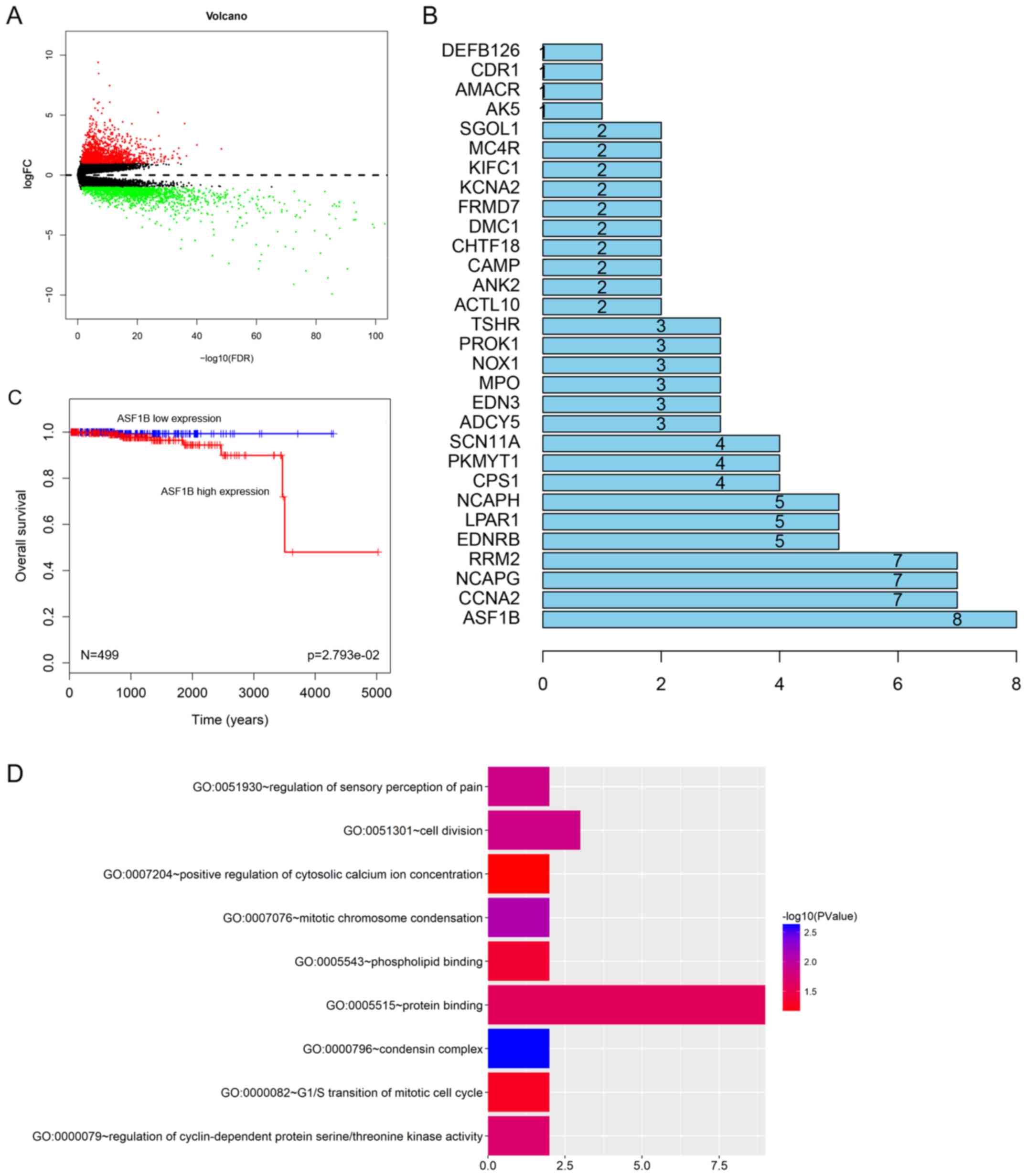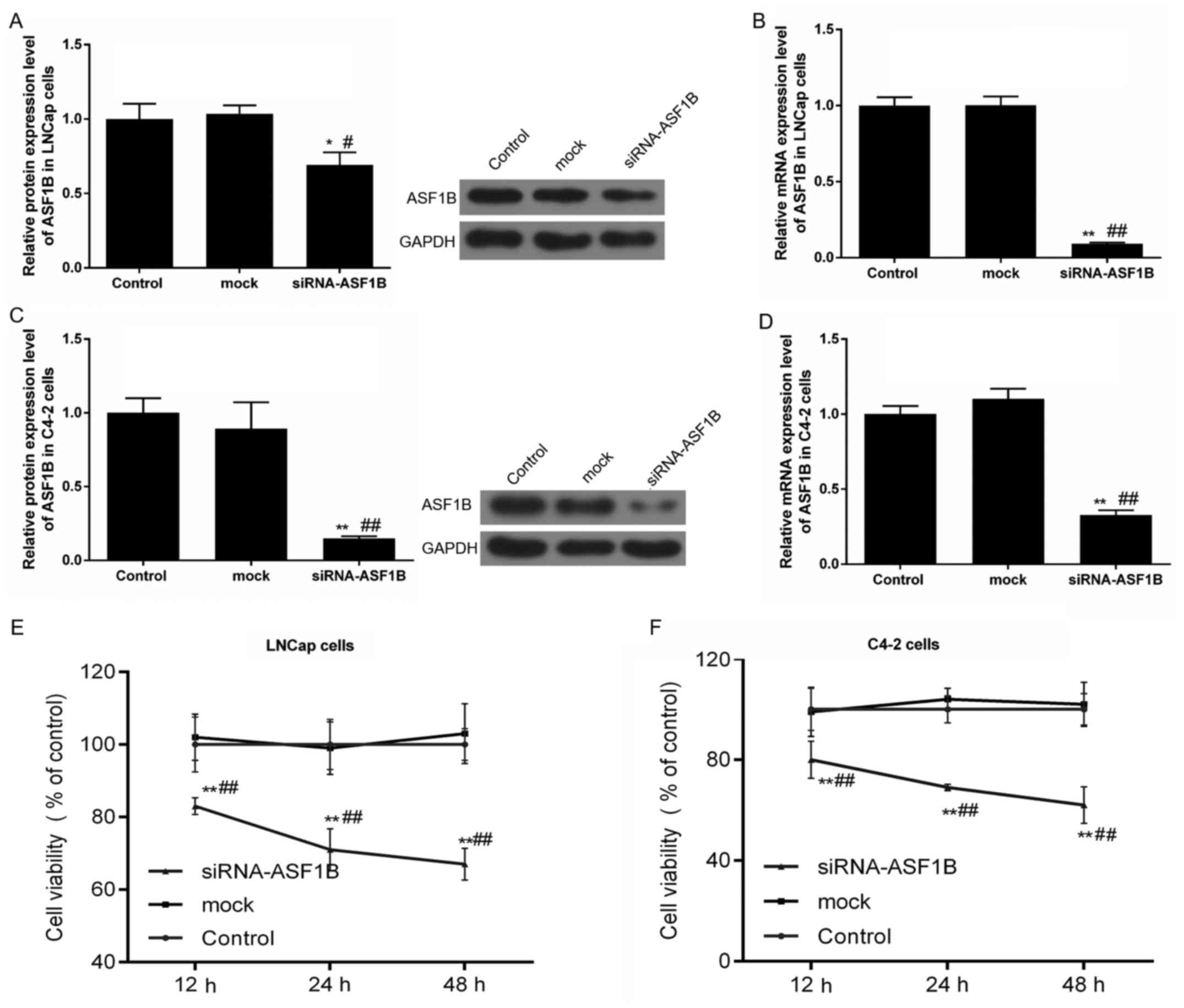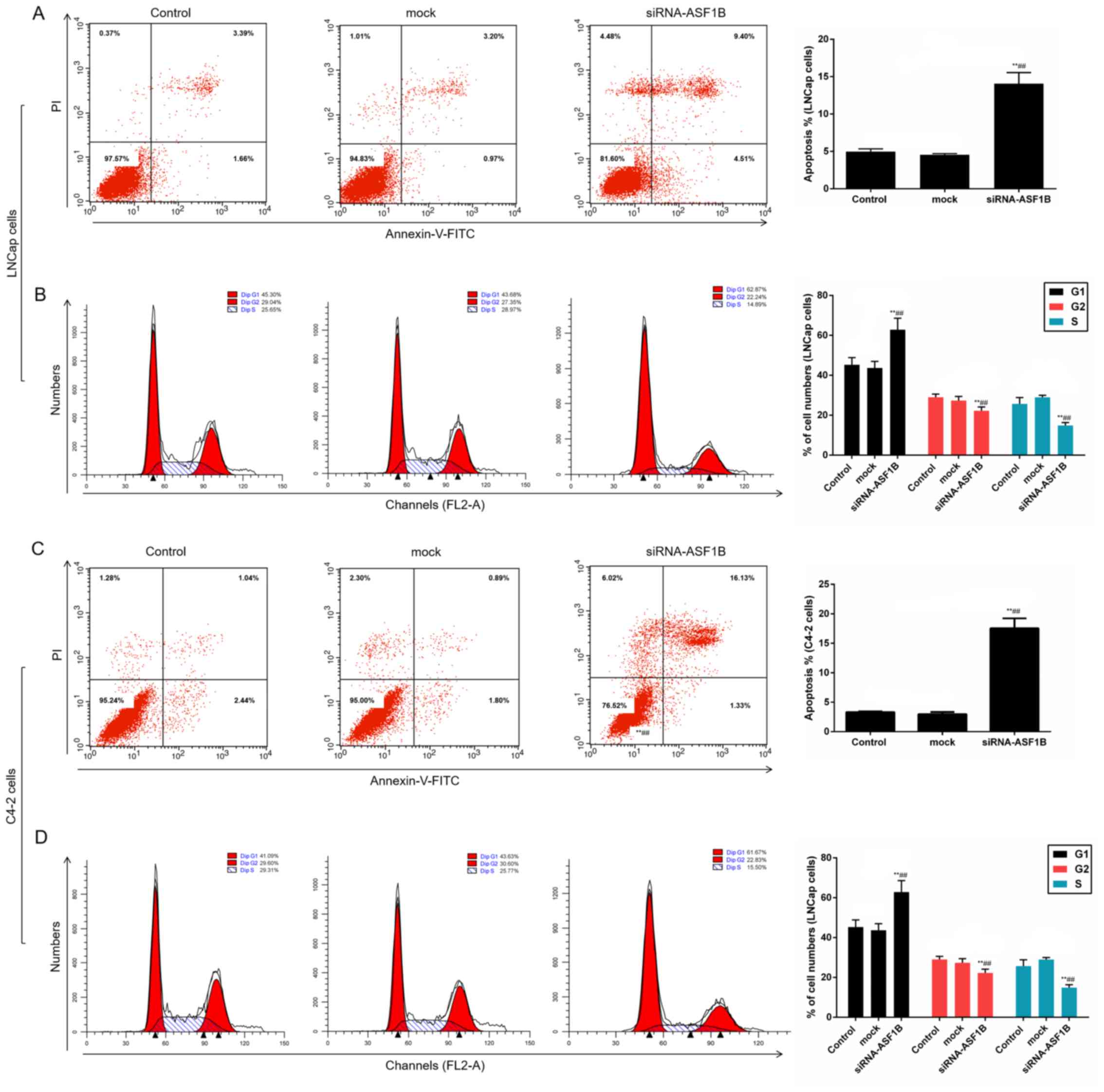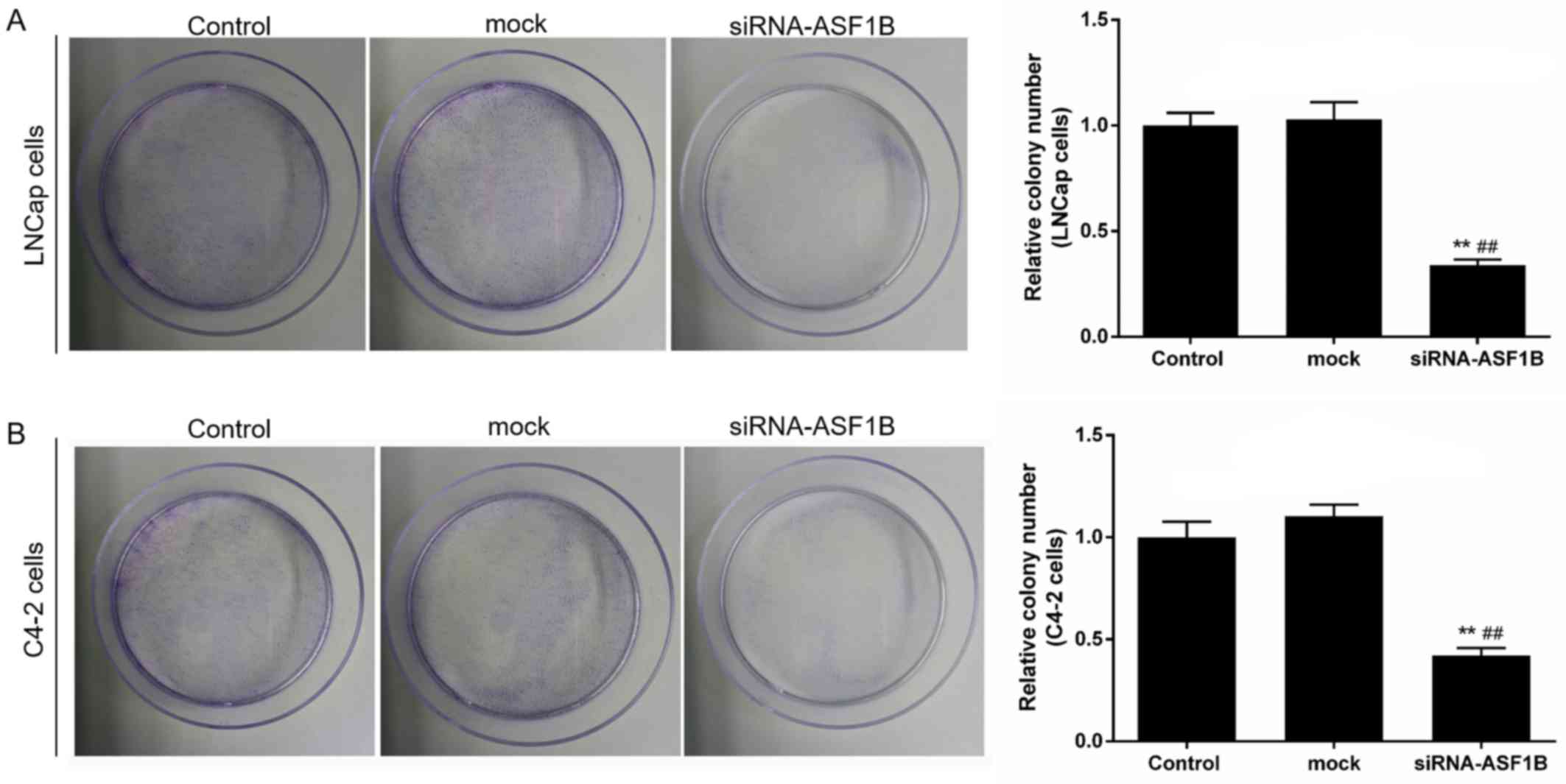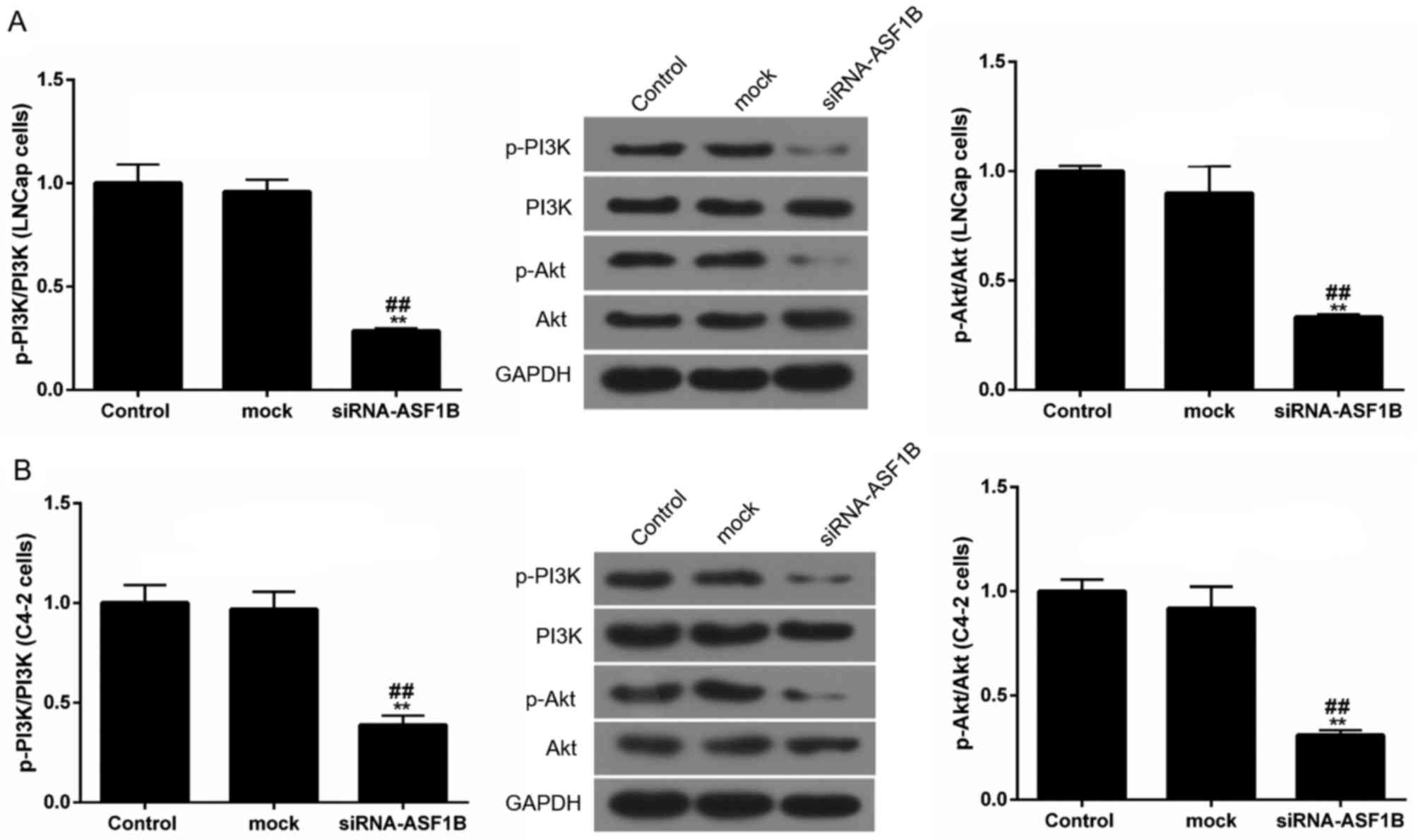Introduction
Prostate cancer (PCa) is one of the most common
malignancies among males worldwide (1,2). The
incidence of PCa has continued to rise in developed countries in
recent years (3-5). To the best of our knowledge, no
clinical symptoms are observable in the early stage of the cancer,
and therefore a majority of patients are diagnosed with PCa in its
advanced stage. The primary treatment methods of PCa are surgery,
radiotherapy, cryosurgery, chemotherapy and endocrinotherapy.
However, the effects of these treatments are not satisfactory, with
the 5-year survival rate of patients with distant metastasis in the
United States remaining ~20% (4,6-8).
Therefore, it is necessary to identify a safe and effective
strategy for treating PCa.
Cancer is known to be a genotypic disease, and
therefore the occurrence of cancer is associated with changes to
gene expression (9-11). In recent years, researchers have
investigated target genes of cancer, and suggest that targeting
therapy may be used to slow down the progression of cancer
(12-15). Several studies have demonstrated
that various genes, including melanoma differentiation associated
gene-9/syntenin, sirtuin 1 and lysine demethylase 1A, contribute to
the growth, metastasis and differentiation of PCa (16-19).
Thus, determining target genes associated with the progression of
PCa is required.
The phosphatidylinositol 3 kinase (PI3K)/protein
kinase B (Akt/PKB) signaling pathway is widely distributed in
cells, and contributes to the regulation of cell growth,
proliferation and differentiation (20,21).
Furthermore, the PI3K/Akt signal transduction pathway serves an
essential role in the occurrence, development, treatment and
prognosis of malignant tumor (22,23).
PI3K, a bridge molecule associated with extra- cellular signal and
cellular responses, serves an essential role in regulating cell
apoptosis. Akt is a type of serine/threonine protein kinase. When
cells are stimulated by extracellular signals, PI3K activates Akt
activity and Akt further activates its downstream factors (24-26).
The present study aimed to explore the genes
associated with the survival time of patients with PCa.
Anti-silencing function 1B histone chaperone (ASF1B) was selected
as a potential molecular involved in PCa and role was investigated.
Thus, data from healthy adjacent and PCa tissues were collected
from the Cancer Genome Atlas (TCGA) database. The differential
genes among cancer and healthy adjacent tissues were analyzed using
the edgeR software package. The core gene was identified using the
DAVID website.
Materials and methods
Selection of core gene and determination
of gene function
The genes in 499 PCa and 52 adjacent healthy tissues
from the TCGA database were analyzed using the edgeR software
package (http://www.bioconductor.org/packages/release/bioc/
html/edgeR.html). Next, 156 genes identified to be significantly
associated with the survival of the patients were screened. The
selected 156 genes were analyzed using the DAVID available online
database (https://david.ncifcrf.gov/). The
functions of the top seven core genes on the cell were investigated
using Gene Ontology (GO) analysis (http://www.geneontology.org/). ASF1B was selected for
subsequent experiments.
Tissue source
Between June 2015 and September 2017, 37 samples of
PCa tissues and healthy adjacent tissues (mean age, 65.5±7 years)
were obtained from patients with PCa who were admitted to The First
Affiliated Hospital of Xinxiang Medical University (Xinxiang,
China). Patients were diagnosed with PCa by biopsy or pathology.
Patients who also had other malignant tumors, coronary heart
disease or diabetes were excluded. All patients signed informed
consent for the use of their tissues in the present study. This
research was approved by the Ethics Committee of The First
Affiliated Hospital of Xinxiang Medical University.
Cell culture
Human prostatic hyperplasia epithelial cell line
(BPH) and PCa cell lines (PC-3, DU145, LNCap, VcaP and C4-2) were
purchased from Beijing Zeping Technology Co., Ltd. (Beijing,
China). PC-3 is derived from a bone metastatic site, and LNCap is
derived from a left supraclavicular lymph node metastatic site. As
a subline of LNCap, C4-2 exhibits androgen- independent growth in
association with skeletal metastasis. DU145 is derived from a brain
metastatic site and VcaP is derived from a vertebra metastatic
site. BPH cells were cultured in Dulbecco's modified Eagle's medium
(DMEM; Beijing Solarbio Science & Technology Co., Ltd.,
Beijing, China) with 10% fetal bovine serum (FBS; Thermo Fisher
Scientific, Inc., Waltham, MA, USA) and penicillin-streptomycin
mixed solution. PC-3, DU145, LNCap, VcaP and C4-2 cells were
cultured in RPMI-1640 (Beijing Solarbio Science & Technology
Co., Ltd., Beijing, China) with 10% FBS and 100X
penicillin-streptomycin mixed solution. All cells were maintained
in a humidified incubator with 5% CO2 at 37°C.
RNA interference and transfection
The human anti-silencing function 1 (ASF1)B-target
small interfering (si)RNA and unspecific scrambled siRNA vectors
were designed and synthesized by Nanjing Kehao Biotechnology Co.,
Ltd. (Nanjing, China). LNCap and C4-2 cells were seeded at a
density of 1×104 cells/well into 6-well plates. The
cells were transfected with siRNA-ASF1B (1 µg) or
siRNA-negative control vector (1 µg) using Hieff Trans™
Liposomal Transfection reagent (Shanghai Yusheng Biotechnology Co.,
Ltd., Shanghai, China) following the manufacturer's protocol. The
cells were incubated at 37°C for 12 h. Next, the cells were
collected and prepared for the subsequent experiments.
Reverse transcription-quantitative
polymerase chain reaction (RT-qPCR)
Tissues and cells of total RNA were extracted using
RNA extraction kit (Promega Corporation, Madison, WI, USA). A total
of 1 µg of RNA was transcribed to cDNA using TianScript cDNA
Synthesis kit (Tiangen Biotech Co., Ltd., Beijing, China). Reaction
conditions were as follows: 85°C for 5 min, and at 4°C for 5 min.
SYBR® Premix Ex Taq™ II kit (Takara, Beijing, China) was
used to amplify cDNA under reaction conditions as follows:
Predegeneration at 92°C for 5 min; denaturation at 92°C for 15 sec;
annealing at 58°C for 30 sec for 30 cycles; and extension at 72°C
for 35 sec. GAPDH was used as the loading control. The
2−ΔΔCq method was applied to compare gene expression
levels. The primers used are listed in Table I.
 | Table ISequences of the primers. |
Table I
Sequences of the primers.
| Primer name | Sequence
(5'-3') | Product size
(bp) |
|---|
| ASF1B | | 231 |
| Forward |
GATCAGCTTCGAGTGCAGTG | |
| Reverse |
TGGTAGGTGCAGGTGATGAG | |
| p53 | | 246 |
| Forward |
GCCCCTCCTCAGCATCTTAT | |
| Reverse |
AAAGCTGTTCCGTCCCAGTA | |
| Cyclin D1 | | 210 |
| Forward |
CCCTCGGTGTCCTACTTCAA | |
| Reverse |
CTTAGAGGCCACGAACATGC | |
| Bax | | 208 |
| Forward |
AACATGGAGCTGCAGAGGAT | |
| Reverse |
CCAATGTCCAGCCCATGATG | |
| Bcl-2 | | 207 |
| Forward |
TTCTTTGAGTTCGGTGGGGT | |
| Reverse |
CTTCAGAGACAGCCAGGAGA | |
| Caspase-3 | | 220 |
| Forward |
TGAGCCATGGTGAAGAAGGA | |
| Reverse |
TCGGCCTCCACTGGTATTTT | |
| GAPDH | | 222 |
| Forward |
CCATCTTCCAGGAGCGAGAT | |
| Reverse |
TGCTGATGATCTTGAGGCTG | |
Western blotting
The proteins of tissues and cells were collected
using RIPA lysate buffer (Beijing Solarbio Science & Technology
Co., Ltd.). Protein concentration was detected using a
bicinchoninic acid assay. Proteins (25 µg/lane) were
separated using 8% SDS-PAGE and were then transferred onto a
polyvinylidene fluoride membrane. The membrane was blocked with 5%
skimmed milk at room temperature 1.5 h. Next, the membrane was
incubated with the primary antibodies (Table II) at 4°C for 24 h. The membrane
was then bound to the donkey anti-mouse IgG (cat. no. ab150109;
1:6,000), goat anti-mouse IgG (cat. no. ab6785; 1:6,000) (both from
Abcam, Cambridge, UK) and donkey anti-rabbit IgG (cat. no. NL004;
1:5,000; R&D Systems, Inc., Minneapolis, MN, USA) secondary
antibodies at 37°C for 1 h. The signal was visualized using
enhanced chemiluminescence (Sangon Biotech Co., Ltd., Shanghai,
China). Quantity One 4.6.2 software (Bio-Rad Laboratories, Inc.,
Hercules, CA, USA) was used to perform densitometry.
 | Table IIAntibodies used in the present
study. |
Table II
Antibodies used in the present
study.
| Antibody | Catalog number | Company | Host animal | Dilution |
|---|
| Anti-ASF1B | ab70126 | Abcama | Rabbit | 1:800 |
| Anti-p53 | AF1335 | R&D Systems,
Inc.b | Goat | 1:600 |
| Anti-cyclin D1 | AF4196 | R&D Systems,
Inc. | Goat | 1:500 |
| Anti-caspase-3 | MAB835 | R&D Systems,
Inc. | Rabbit | 1:500 |
| Anti- Bcl-2 | 2872 | Cell Signaling
Technology, Inc.c | Rabbit | 1:1,000 |
| Anti-Bax | 2772 | Cell Signaling
Technology, Inc. | Rabbit | 1:1,000 |
| Anti-p-PI3K | ab182651 | Abcam | Rabbit | 1:600 |
| Anti-PI3K | ab191606 | Abcam | Rabbit | 1:800 |
| Anti-p-Akt | AF887 | R&D Systems,
Inc. | Rabbit | 1:1,000 |
| Anti-Akt | MAB2055 | R&D Systems,
Inc. | Mouse | 1:1,000 |
| Anti-GAPDH | 2275-PC-100 | R&D Systems,
Inc. | Rabbit | 1:1,000 |
Cell counting kit-8 (CCK-8) analysis
Cell viability was examined using a CCK-8 kit
(Beijing Solarbio Science & Technology Co., Ltd.) following the
manufacturer's protocol. In brief, LNCap and C4-2 cells were plated
in 96-well plates (1.5×103 cell/well) in an incubator
for 24 h. Cells were exposed to PBS (control), unspecific scrambled
siRNA plasmid (mock) and ASF1B-target siRNA (siRNA-ASF1B) for 12,
24 and 48 h. Next, CCK-8 solution was added to the cells and
incubated for 4 h. Absorbance at 450 nm was recorded and evaluated
using a microplate reader.
Flow cytometry analysis
Cell apoptosis was examined using an Annexin
V-fluorescein isothiocyanate (FITC)/propidium iodide (PI) apoptosis
detection kit (Sigma-Aldrich; Merck KGaA, Darmstadt, Germany).
LNCap and C4-2 cells were inoculated in 6-well plates
(3×104 cells/well) in the incubator for 24 h. All cells
were treated as aforementioned. Next, cells were digested by 0.25%
trypsin for 2 min at room temperature. The trypsin was discarded
and cells were re-suspended in Annexin V binding buffer. The
Annexin V-FITC and PI were added to cells and incubated for 20 min
in the dark at room temperature. BD FACSAria I/II flow cytometry
was performed to measure cell apoptosis and analysis was performed
using BD CellQuest Pro 3.3 software (both from BD Biosciences, San
Jose, CA, USA).
Cell cycle analysis was performed using a
PI dye kit (Beyotime Institute of Biotechnology, Shanghai, China)
following the manufacturer's protocol
Briefly, LNCap and C4-2 cells were treated as
aforementioned. The PI and RNAse mix was added to the cells in the
dark at 37°C for 20 min. Cell cycle was analyzed using flow
cytometry.
Colony formation analysis
The colony formation of cells was determined using
crystal violet staining (Beijing Solarbio Science & Technology
Co., Ltd.). Briefly, LNCap and C4-2 cells were inoculated in 6-well
plates (3×104 cell/well) and incubated for 24 h. All
cells were treated as aforementioned. Cells were then fixed with
100% methanol for 10 min at room temperature. Next, cells were
stained by 0.1% crystal violet for 5 min at room temperature.
Finally, the cell colonies were observed under an inverted
microscope (IX73; Olympus Corporation, Tokyo, Japan; magnification,
×2.5). The number of the colonies containing >50 cells was
counted to calculate the colony formation as follows: (Number of
colonies/number of cells) ×100%.
Statistical analysis
IBM SPSS Statistics 20.0 software (IBM, Corp.,
Armonk, NY, USA) was used for statistical analysis. Data are
presented as the mean ± standard deviation. One-way analysis of
variance followed by Tukey's text was performed to compare the
differences among groups. The differences between tumor and healthy
adjacent tissues were calculated using a paired Student's t-test.
Kaplan Meier survival analysis with a log-rank test was performed
to compare the overall survival rate of patients grouped by high
and low ASF1B expression. The association between the expression of
ASF1B and the clinicopathological features of patients with PCa
were assessed using the Chi-square test. P<0.05 was considered
to indicate a statistically significant difference. The experiments
were independently repeated at least three times.
Results
ASF1B is identified as the core gene
To identify the core gene, data from 52 healthy
adjacent tissues and 499 PCa tissues were collected from the TCGA
database. A total of 2,971 genes were investigated (Fig. 1A) and 156 genes were identified to
be significantly associated with the survival rate of patients with
PCa (Fig. 1B). A high expression
of ASF1B was associated with the poor prognosis of patients with
PCa (Fig. 1C). In addition, GO
analysis demonstrated that seven core genes in PCa were
significantly associated with cell cycle distribution and cell
differentiation (Fig. 1D), the
ASF1B gene was selected as the core gene in the present study. To
determine the role of the expression of ASF1B in PCa, the
pathological features of patients with PCa were analyzed. The data
demonstrated the high ASF1B expression was significantly associated
with tumor node metastasis (TNM) stage and metastasis; however, no
significant association was identified between ASF1B expression and
other pathological features (Table
III; P>0.05).
 | Table IIIAssociation between the expression
levels of ASF1B and the clinicopathological features of patients
with prostate cancer. |
Table III
Association between the expression
levels of ASF1B and the clinicopathological features of patients
with prostate cancer.
| Features | Number of
patients | Low ASF1B
expression (%) | High ASF1B
expression (%) | P-value |
|---|
| Age (years) | | | | 0.538 |
| <55 | 16 | 10 (47.6) | 6 (37.5) | |
| ≥55 | 21 | 11 (52.4) | 10 (62.5) | |
| PSA (ng/ml) | | | | 0.942 |
| <4 | 15 | 8 (44.4) | 7 (36.8) | |
| ≥4 | 22 | 10 (55.6) | 12 (63.2) | |
| TNM stage | | | | 0.012a |
| I/II | 12 | 8 (57.1) | 4 (17.4) | |
| III/IV | 25 | 6 (42.9) | 19 (82.6) | |
| Histological
differentiation | | | | 0.060 |
| Well | 3 | 2 (12.5) | 1 (4.7) | |
| Moderate | 12 | 8 (50.0) | 4 (19) | |
| Poor | 22 | 6 (37.5) | 16 (76.3) | |
| Metastasis | | | | 0.010a |
| No | 23 | 15 (83.3) | 8 (42.1) | |
| Yes | 14 | 3 (16.7) | 11 (57.9) | |
ASF1B is highly expressed in the PCa
tissues and cells
RT-qPCR and western blotting were performed in order
to examine the expression of ASF1B in the PCa and healthy adjacent
tissues. It was demonstrated that the mRNA expression of ASF1B in
cancer tissues were significantly higher compared with that in
healthy adjacent tissues (Fig. 2A;
P<0.01). A total of six patients from the cohort were randomly
selected to measure the protein expression of ASF1B. The results
revealed that there was at least a 2-fold increase in the protein
expression of ASF1B in cancer tissues compared with that in the
healthy adjacent tissues (Fig. 2B;
P<0.01). Furthermore, the mRNA and protein levels of ASF1B in
normal cells (BPH) were significantly lower compared with those in
the PCa cells (PC-3, DU145, LNCap, VcaP and C4-2) (Fig. 2C and D; P<0.01). The expression
levels of ASF1B in LNCap and C4-2 cells were the highest compared
with those in other cell lines. Hence, LNCap and C4-2 cells were
selected for subsequent studies.
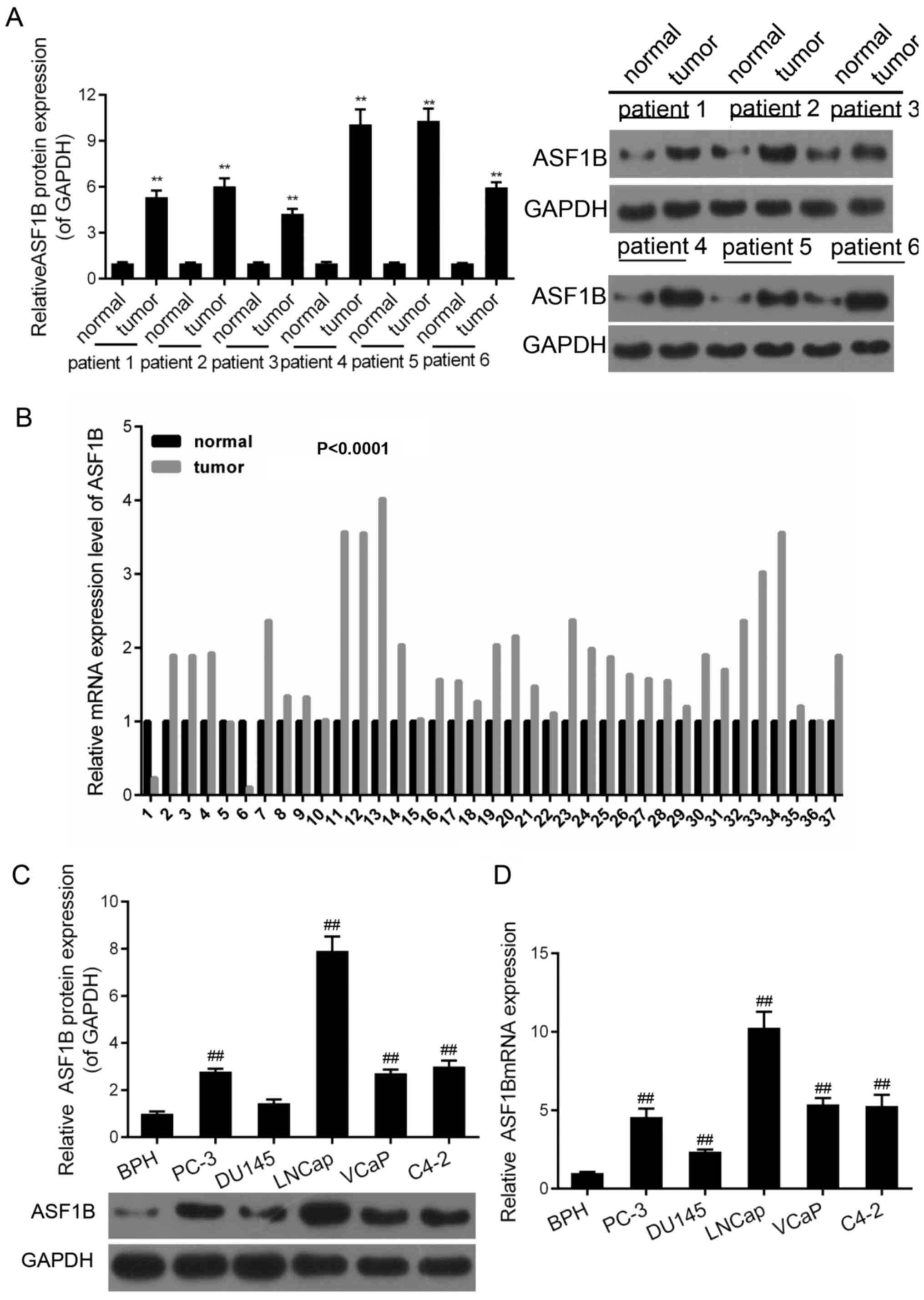 | Figure 2ASF1B is highly expressed in the
prostate cancer tissues and cells. Between June 2015 and September
2017, 37 samples of prostate cancer tissues and adjacent tissues
were obtained from patients with prostate cancer who were treated
at the First Affiliated Hospital of Xinxiang Medical University.
(A) Western blotting was performed to evaluate the protein
expression of ASF1B in tissues (relative to the internal control,
GAPDH). **P<0.01 vs. normal (healthy adjacent
tissues). (B) RT-qPCR was used to detect the mRNA level of ASF1B in
tissues. (C) The protein levels of ASF1B in BPH, PC-3, DU145,
LNCap, VcaP and C4-2 were tested by western blotting (relative to
the internal control, GAPDH). ##P<0.01 vs. BPH. (D)
The mRNA levels of ASF1B in BPH, PC-3, DU145, LNCap, VcaP and C4-2
were assessed by RT-qPCR. GAPDH was presented as sample control.
##P<0.01 vs. BPH. ASF1B, anti-silencing function 1B
histone chaperone; RT-qPCR, reverse transcription-quantitative
polymerase chain reaction. |
siASF1B decreases the viability of LNCap
and C4-2 cells
The transfection efficiencies of the siRNA-ASF1B
plasmid in LNCap and C4-2 cells were examined by RT-qPCR and
western blotting. The results of the present study observed a
significant decrease in ASF1B protein and mRNA expression (Fig. 3A and B; P<0.05) following the
transfection of LNCap with the siRNA-ASF1B plasmid compared with
the mock control group. Furthermore, the ASF1B protein and mRNA
expression levels were reduced by siRNA-ASF1B transfection in C4-2
cells (Fig. 3C and D;
P<0.05).
The viabilities of LNCap and C4-2 cells were
examined using a CCK-8 assay. The CCK-8 data demonstrated that the
viabilities significantly decreased in siRNA-ASF1B-transfected
LNCap and C4-2 cells compared with the mock (Fig. 3E and F; P<0.01). Following
transfection for 12 h, cell viability was significantly decreased
with si-ASF1B. Thus, the si-ASF1B transfection duration was set as
12 h.
siASF1B induces apoptosis and arrests
LNCap and C4-2 cells at the G1 phase
The data in the present study revealed that compared
with the mock control, siRNA-ASF1B significantly enhanced the
apoptotic and promoted the cell cycle arrest of LNCap cells
(Fig. 4A and B; P<0.01).
Additionally, when C4-2 cells were treated with siRNA-ASF1B, the
apoptosis and the number of cells in G1 phase were significantly
increased, whereas the number of cells in G2 and S phases was
decreased significantly (Fig. 4C
and D; P<0.01).
siASF1B inhibits the proliferation of
LNCap and C4-2 cells
In order to identify the effect of siASF1B on the
proliferation of LNCap and C4-2 cells, colony formation analysis
was performed. The results revealed that the colony formation of
LNCap and C4-2 cells was significantly attenuated by siRNA- ASF1B
transfection compared with the mock group (Fig. 5; P<0.01).
siASF1B regulates apoptosis-associated
factors in LNCap and C4-2 cells
The results demonstrated that the protein and mRNA
levels of cyclin D1 and Bcl-2 were downregulated; however, the
protein and mRNA levels of p53, caspase-3 and Bax were upregulated
in siRNA-ASF1B-transfected LNCap cells, compared with the mock
group (Fig. 6A and B; P<0.01).
In addition, the protein and mRNA expression levels of these
factors in C4-2 cells were in accordance with those observed in
LNCap cells (Fig. 6C and D;
P<0.01).
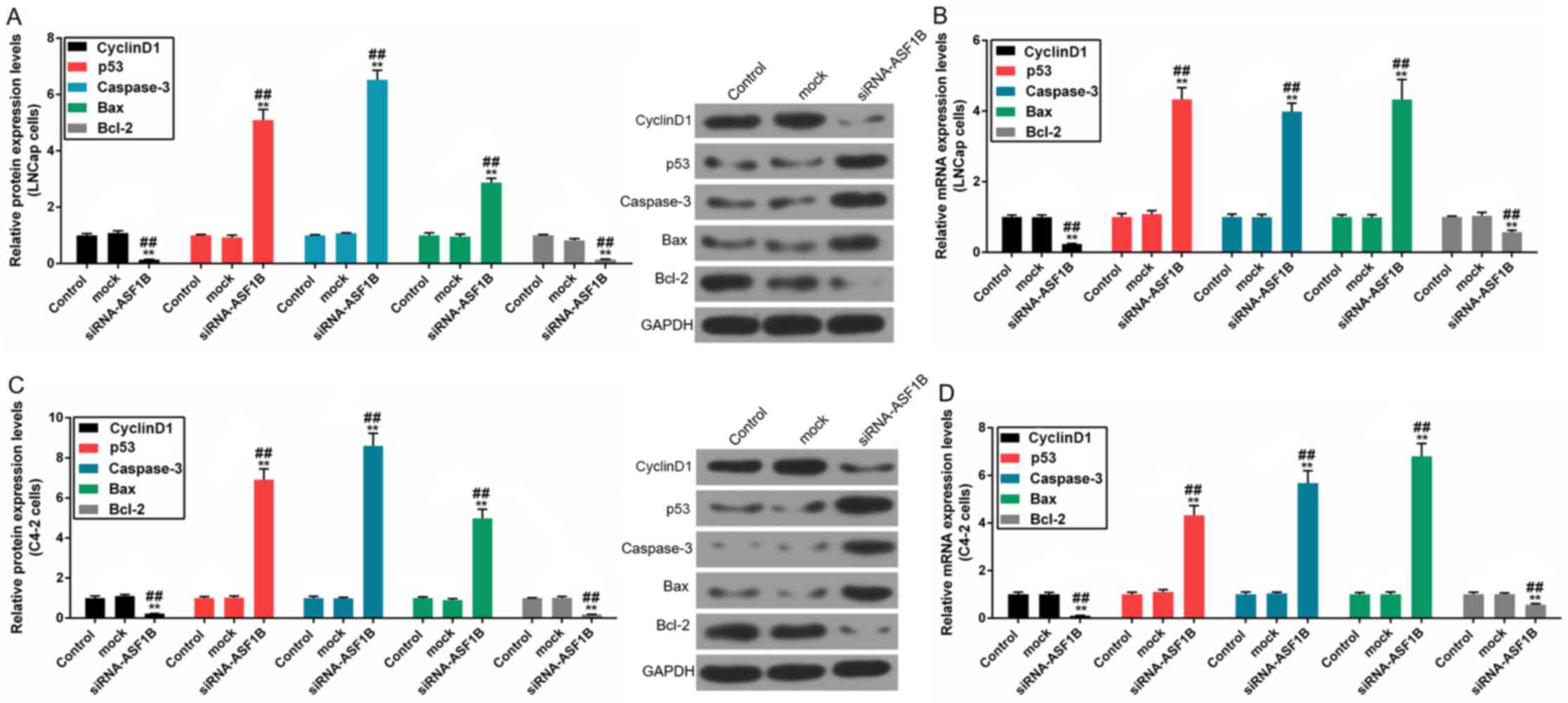 | Figure 6siASF1B regulates proliferation- and
apoptosis-associated factors in LNCap and C4-2 cells. The protein
and mRNA levels of p53, cyclin D1, caspase-3, Bax and Bcl-2 in
LNCap and C4-2 cell were determined by western blotting (relative
to the internal control, GAPDH) and reverse transcription-
quantitative polymerase chain reaction. The (A) protein and (B)
mRNA levels of p53, cyclin D1, caspase-3, Bax and Bcl-2 in LNCap
cells. The (C) protein and (D) mRNA levels of p53, cyclin D1,
caspase-3, Bax and Bcl-2 in.C4-2 cells. **P<0.01 vs.
control; ##P<0.01 vs. mock. ASF1B, anti-silencing
function 1B histone chaperone; si, small inteferring RNA; Bax,
Bcl-2-associated X protein; Bcl-2, B-cell lymphoma 2. |
siASF1B suppresses the PI3K/Akt signaling
pathway in LNCap and C4-2 cells
In order to further explore the possible mechanism
of siASF1B in LNCap and in C4-2 cells, western blotting was
performed to detect the protein expression levels of p-PI3K, PI3K,
p-Akt and Akt. Western blotting data demonstrated that siRNA-ASF1B
significantly reduced the phosphorylation levels of PI3K and Akt in
LNCap and C4-2 cells by at least a third compared with the mock
control group. However, the levels of PI3K and Akt remained stable
among other groups. The proportions of p-PI3K/PI3K and p-Akt/Akt in
siRNA-ASF1B were significantly reduced compared with those in the
mock group (Fig. 7;
P<0.01).
Discussion
In the present study, ASF1B was identified to be
associated with cell cycle and cell differentiation in PCa. ASF1
was initially identified in yeast, and belongs to the histone H3-H4
chaperone protein. ASF1 regulates chromatin functions and has been
demonstrated to contribute to tumorigenesis (27). ASF1 has two primary subtypes, which
are ASF1A and ASF1B (28). Studies
have reported that ASF1B is highly expressed in the human thymus
and testicles (29). In addition,
ASF1B has been reported to participate in the development of
cervical and breast cancer (30,31).
However, the role of ASF1B in PCa remains unclear. Therefore, the
present study aimed to explore the function of ASF1B in PCa.
The results revealed that ASF1B was highly expressed
in PCa tissues and cells compared with healthy tissues and cells,
respectively. This result is similar to the high expression of
ASF1B identified in breast cancer and cervical carcinoma (30,31).
Furthermore, the results of the present study revealed that high
expression of ASF1B was associated with a low overall survival
rate, and that the expression of ASF1B was associated with TNM
stage and metastasis.
A previous study has demonstrated that the
overexpression of ASF1B markedly enhances the proliferation of
breast cancer (30). Thus, we
hypothesized that siASF1B may decrease the growth of PCa cells. The
results also demonstrated that siRNA-ASF1B significantly decreased
the viability and the colon formation of LNCap and C4-2 cells
compared with control cells. Cell proliferation is associated with
cell cycle distribution. Changes in proliferation participate in
the regulation of cell cycle phases, including G1, G2 and S
(32,33). In the present study, the data
revealed that siRNA-ASF1B induced G1 phase cell cycle arrest.
Consistently, researches have also confirmed previously that
various anti-genes promote G1 phase arrest and inhibit the cyclin
D1 expression in cancer cells (34-37).
Similarly, the present results indicated that siRNA-ASF1B inhibited
the expression levels of cyclin D1 in LNCap and C4-2 cells
suggesting that ASF1B silencing promotes cell cycle arrest of
PCa.
Apoptosis is another important process in the
progression of tumors. Anticancer drugs and genes serve important
roles in promoting the process of cancer apoptosis (38-40).
Therefore, the effect of siASF1B on the apoptosis of PCa was
analyzed. The results revealed that siRNA-ASF1B increased the
apoptosis rate of LNCap and C4-2 cells. To further verify the
inhibitory effect of siASF1B on apoptosis, factors associated with
apoptosis were investigated. Bax and p53 are pro-apoptotic genes,
and Bcl-2 is an anti-apoptotic gene (41,42).
Additionally, studies demonstrated that the activity of caspase-3
is strengthened during the process of cell apoptosis (43-45).
In the present study, siRNA-ASF1B significantly upregulated the
levels of p53, cleaved caspase-3 and Bax. However, siRNA-ASF1B
treatment significantly downregulated Bcl-2 expression. These
results indicated that the knockdown of ASF1B accelerated the
apoptosis of PCa cells by inhibiting Bcl-2 expression, and
enhancing the expression levels of p53, caspase-3 and Bax.
Consistently, ASF1B has been reported as a necessary factor for
promoting cell proliferation in breast cancer (30). A previous study indicated that
ASF1B may be a therapeutic target in cancer (46). Taken together, it was concluded
that the downregulation of ASF1B exerted an antitumor effect on PCa
by promoting cell apoptosis and cell cycle arrest.
The PI3K/Akt signaling pathway serves a role in cell
growth and proliferation, and has been observed to be dysregulated
in various cancer types (47). A
previous study demonstrated that the PI3K/Akt signaling pathway is
inactivated, whereas osthole promotes the apoptosis of esophageal
squamous cell carcinoma (48).
Furthermore, repression of the PI3K/Akt signaling pathway inhibits
cell viability and may enhance the apoptosis of PCa (49), indicating the role of the PI3K/Akt
signaling pathway during tumor progression. Thus, the expression of
PI3K and Akt was determined in the present study in order to
explore the role of the PI3K/Akt pathway in the antitumor effect of
si-ASF1B. The data revealed that siRNA-ASF1B significantly reduced
the phosphorylation levels of PI3K and Akt in LNCap and C4-2 cells,
suggesting that the silencing of ASF1B decreased the activity of
the signaling PI3K/Akt pathway in PCa. Thus, inhibition of the
PI3K/Akt pathway may be a possible mechanism underlying the
antitumor effect of si-ASF1B in PCa.
In conclusion, the results of the present study
demonstrated that ASF1B was highly upregulated in PCa. ASF1B
silencing significantly induced G1 phase arrest, promoted cell
apoptosis, and inhibited colon formation in PCa cells. The
inhibition of the PI3K/Akt signaling pathway may be a possible
contributor to the production of antitumor effect of si-ASF1B.
These results suggest that the depletion of ASF1B may inhibit the
progression of PCa and may be a potential target in treating
PCa.
Funding
No funding was received.
Availability of data and materials
The analyzed data sets generated during the study
are available from the corresponding author on reasonable
request.
Authors' contributions
GYH and XJZ wrote the manuscript. GYH, XJZ, PL, QFY,
ZYL and QNY performed the experiments. GYH and XXW designed the
study. XJZ, PL and XXW performed the data analysis. GYH, XJZ and
XXW revised the manuscript. All authors reviewed the
manuscript.
Ethics approval and consent to
participate
All patients recruited to the present study provided
written informed consent for the utilization of their tissue
samples for clinical research. The project protocol was approved by
the Ethics Committee of The First Affiliated Hospital of Xinxiang
Medical University.
Patient consent for publication
Written informed consent was obtained from all
participants for the publication of their data.
Competing interests
The authors declare that they have no competing
interests.
Acknowledgments
Not applicable.
References
|
1
|
Pérez-Rambla C, Puchades-Carrasco L,
García-Flores M, Rubio- Briones J, López-Guerrero JA and
Pineda-Lucena A: Non-invasive urinary metabolomic profiling
discriminates prostate cancer from benign prostatic hyperplasia.
Metabolomics. 13:522017. View Article : Google Scholar : PubMed/NCBI
|
|
2
|
Bell KJ, Del Mar C, Wright G, Dickinson J
and Glasziou P: Prevalence of incidental prostate cancer: A
systematic review of autopsy studies. Int J Cancer. 137:1749–1757.
2015. View Article : Google Scholar : PubMed/NCBI
|
|
3
|
Hoffman KE, Chen MH, Moran BJ,
Braccioforte MH, Dosoretz D, Salenius S, Katin MJ, Ross R and
D'Amico AV: Prostate cancer-specific mortality and the extent of
therapy in healthy elderly men with high-risk prostate cancer.
Cancer. 116:2590–2595. 2010. View Article : Google Scholar : PubMed/NCBI
|
|
4
|
Rim SH, Hall IJ, Massetti GM, Thomas CC,
Li J and Richardson LC: Primary care providers' intended use of
decision aids for prostate-specific antigen testing for prostate
cancer screening. J Cancer Educ. 2018. View Article : Google Scholar : PubMed/NCBI
|
|
5
|
Shin H, Park YH, Kim YG, Lee JY and Park
J: Aqueous two-phase system to isolate extracellular vesicles from
urine for prostate cancer diagnosis. PLoS One. 13:e01948182018.
View Article : Google Scholar : PubMed/NCBI
|
|
6
|
Li XX, Zhang YG, Wang D, Chen YF and Shan
YH: Preventive effects of aspirin on cardiovascular complications
in prostate cancer cases after endocrinotherapy. Asian Pac J Cancer
Prev. 16:4909–4913. 2015. View Article : Google Scholar : PubMed/NCBI
|
|
7
|
Liu Q, Tong D, Liu G, Yi Y, Xu J, Yang X,
Wang L, Zhang J, Ye J, Zhang Y, et al: A novel BRCA2 mutation in
prostate cancer sensitive to combined radiotherapy and androgen
deprivation therapy. Cancer Biol Ther. 19:669–675. 2018. View Article : Google Scholar : PubMed/NCBI
|
|
8
|
Sheng MX, Wan LL, Liu CM, Liu CX and Chen
SS: Cytoreductive cryosurgery in patients with bone metastatic
prostate cancer: A retrospective analysis. Kaohsiung J Med Sci.
33:609–615. 2017. View Article : Google Scholar : PubMed/NCBI
|
|
9
|
Augello G, Balasus D, Fusilli C, Mazza T,
Emma MR, Giannitrapani L, Agliastro R, Cervello M and Montalto G:
Association between MICA gene variants and the risk of hepatitis C
virus-induced hepatocellular cancer in a sicilian population
sample. OMICS. 22:274–282. 2018. View Article : Google Scholar : PubMed/NCBI
|
|
10
|
Concolino A, Olivo E, Tammè L, Fiumara CV,
De Angelis MT, Quaresima B, Agosti V, Costanzo FS, Cuda G and
Scumaci D: Proteomics analysis to assess the role of mitochondria
in BRCA1- mediated breast tumorigenesis. Proteomes. 6:62018.
View Article : Google Scholar
|
|
11
|
Xu Y, Zhang C, Liang H, Hu S, Li P, Liu L,
Duan X, Chen C, Zhang Y and Dai P: Dishevelled 1, a pivotal
positive regulator of the Wnt signalling pathway, mediates
5-fluorouracil resistance in HepG2 cells. Artif Cells Nanomed
Biotechnol. Mar 27–2018.Epub ahead of print. View Article : Google Scholar
|
|
12
|
Bohlen J, McLaughlin SL, Hazard-Jenkins H,
Infante AM, Montgomery C, Davis M and Pistilli EE: Dysregulation of
metabolic-associated pathways in muscle of breast cancer patients:
Preclinical evaluation of interleukin-15targeting fatigue. J
Cachexia Sarcopenia Muscle. 2018. View Article : Google Scholar
|
|
13
|
Kalimuthu S, Zhu L, Oh JM, Lee HW,
Gangadaran P, Rajendran RL, Baek SH, Jeon YH, Jeong SY, Lee SW, et
al: Regulated mesenchymal stem cells mediated colon cancer therapy
assessed by reporter gene based optical imaging. Int J Mol Sci.
19:192018. View Article : Google Scholar
|
|
14
|
Liu H, Schreiber SL and Stockwell BR:
Targeting dependency on the GPX4 lipid peroxide repair pathway for
cancer therapy. Biochemistry. 57:2059–2060. 2018. View Article : Google Scholar : PubMed/NCBI
|
|
15
|
Tremblay-LeMay R, Rastgoo N and Chang H:
Modulating PD-L1 expression in multiple myeloma: An alternative
strategy to target the PD-1/PD-L1 pathway. J Hematol Oncol.
11:462018. View Article : Google Scholar : PubMed/NCBI
|
|
16
|
Das SK, Pradhan AK, Bhoopathi P, Talukdar
S, Shen XN, Sarkar D, Emdad L and Fisher PB: The MDA-9/Syntenin/
IGF-1R/STAT3 axis directs prostate cancer invasion. Cancer Res.
78:2852–2863. 2018. View Article : Google Scholar : PubMed/NCBI
|
|
17
|
Karbasforooshan H, Roohbakhsh A and Karimi
G: SIRT1 and microRNAs: The role in breast, lung and prostate
cancers. Exp Cell Res. 367:1–6. 2018. View Article : Google Scholar : PubMed/NCBI
|
|
18
|
Li P, You S, Nguyen C, Wang Y, Kim J,
Sirohi D, Ziembiec A, Luthringer D, Lin SC, Daskivich T, et al:
Genes involved in prostate cancer progression determine MRI
visibility. Theranostics. 8:1752–1765. 2018. View Article : Google Scholar : PubMed/NCBI
|
|
19
|
Sehrawat A, Gao L, Wang Y, Bankhead A III,
McWeeney SK, King CJ, Schwartzman J, Urrutia J, Bisson WH, Coleman
DJ, et al: LSD1 activates a lethal prostate cancer gene network
independently of its demethylase function. Proc Natl Acad Sci USA.
115:E4179–E4188. 2018.PubMed/NCBI
|
|
20
|
Brufsky AM and Dickler MN: Estrogen
receptor-positive breast cancer: Exploiting signaling pathways
implicated in endocrine resistance. Oncologist. 23:528–539. 2018.
View Article : Google Scholar : PubMed/NCBI
|
|
21
|
Mohammadi A, Amooeian VG and Rashidi E:
Dysfunction in brain-derived neurotrophic factor signaling pathway
and susceptibility to schizophrenia, Parkinson's and Alzheimer's
diseases. Curr Gene Ther. 18:45–63. 2018. View Article : Google Scholar : PubMed/NCBI
|
|
22
|
Danielsen SA, Eide PW, Nesbakken A, Guren
T, Leithe E and Lothe RA: Portrait of the PI3K/AKT pathway in
colorectal cancer. Biochim Biophys Acta. 1855.104–121. 2015.
|
|
23
|
Toren P and Zoubeidi A: Targeting the
PI3K/Akt pathway in prostate cancer: Challenges and opportunities
(Review). Int J Oncol. 45:1793–1801. 2014. View Article : Google Scholar : PubMed/NCBI
|
|
24
|
Liu ST, Hui G, Mathis C, Chamie K, Pantuck
AJ and Drakaki A: The current status and future role of the
phosphoinositide 3 kinase/ AKT signaling pathway in urothelial
cancer: An old pathway in the new immunotherapy era. Clin
Genitourin Cancer. 16:e269–e276. 2018. View Article : Google Scholar
|
|
25
|
Pompura SL and Dominguez-Villar M: The
PI3K/AKT signaling pathway in regulatory T-cell development,
stability, and function. J Leukoc Biol. 103:1065–1076. 2018.
View Article : Google Scholar
|
|
26
|
Ramakrishnan V and Kumar S: PI3K/AKT/mTOR
pathway in multiple myeloma: From basic biology to clinical
promise. Leuk Lymphoma. Jan 11–2018.Epub ahead of print. View Article : Google Scholar : PubMed/NCBI
|
|
27
|
Seol JH, Song TY, Oh SE, Jo C, Choi A, Kim
B, Park J, Hong S, Song I, Jung KY, et al: Identification of small
molecules that inhibit the histone chaperone Asf1 and its chromatin
function. BMB Rep. 48:685–690. 2015. View Article : Google Scholar : PubMed/NCBI
|
|
28
|
De Koning L, Corpet A, Haber JE and
Almouzni G: Histone chaperones: An escort network regulating
histone traffic. Nat Struct Mol Biol. 14:997–1007. 2007. View Article : Google Scholar : PubMed/NCBI
|
|
29
|
Umehara T and Horikoshi M: Transcription
initiation factor IID-interactive histone chaperone CIA-II
implicated in mammalian spermatogenesis. J Biol Chem.
278:35660–35667. 2003. View Article : Google Scholar : PubMed/NCBI
|
|
30
|
Corpet A, De Koning L, Toedling J,
Savignoni A, Berger F, Lemaître C, O'Sullivan RJ, Karlseder J,
Barillot E, Asselain B, et al: Asf1b, the necessary Asf1 isoform
for proliferation, is predictive of outcome in breast cancer. EMBO
J. 30:480–493. 2011. View Article : Google Scholar :
|
|
31
|
Rosty C, Sheffer M, Tsafrir D, Stransky N,
Tsafrir I, Peter M, de Crémoux P, de La Rochefordière A, Salmon R,
Dorval T, et al: Identification of a proliferation gene cluster
associated with HPV E6/E7 expression level and viral DNA load in
invasive cervical carcinoma. Oncogene. 24:7094–7104. 2005.
View Article : Google Scholar : PubMed/NCBI
|
|
32
|
Mens MMJ and Ghanbari M: Cell cycle
regulation of stem cells by MicroRNAs. Stem Cell Rev. 14:309–322.
2018. View Article : Google Scholar : PubMed/NCBI
|
|
33
|
Uzquiano A, Gladwyn-Ng I, Nguyen L, Reiner
O, Götz M, Matsuzaki F and Francis F: Cortical progenitor biology:
Key features mediating proliferation versus differentiation. J
Neurochem. Mar 23–2018.Epub ahead of print. View Article : Google Scholar : PubMed/NCBI
|
|
34
|
Jiang H, Zhu Y, Zhou Z and Xu J, Jin S, Xu
K, Zhang H, Sun Q, Wang J and Xu J: PRMT5 promotes cell
proliferation by inhibiting BTG2 expression via the ERK signaling
pathway in hepatocellular carcinoma. Cancer Med. 7:869–882. 2018.
View Article : Google Scholar : PubMed/NCBI
|
|
35
|
Leem DG, Shin JS, Kim KT, Choi SY, Lee MH
and Lee KT: Dammarane-type triterpene ginsenoside-Rg18 inhibits
human non-small cell lung cancer A549 cell proliferation via G1
phase arrest. Oncol Lett. 15:6043–6049. 2018.PubMed/NCBI
|
|
36
|
Yue Y, Yuan Y, Li L, Fan J, Li C, Peng W
and Ren G: Homeobox protein MSX1 inhibits the growth and metastasis
of breast cancer cells and is frequently silenced by promoter
methylation. Int J Mol Med. 41:2986–2996. 2018.PubMed/NCBI
|
|
37
|
Zhang Y, Chen S, Wei C, Rankin GO,
Rojanasakul Y, Ren N, Ye X and Chen YC: Dietary compound
proanthocyanidins from Chinese bayberry (Myrica rubra Sieb. et
Zucc.) leaves inhibit angiogenesis and regulate cell cycle of
cisplatin-resistant ovarian cancer cells via targeting Akt pathway.
J Funct Foods. 40:573–581. 2018. View Article : Google Scholar : PubMed/NCBI
|
|
38
|
Lin CL, Lee CH, Chen CM, Cheng CW, Chen
PN, Ying TH and Hsieh YH: Protodioscin induces apoptosis through
ROS-mediated endoplasmic reticulum stress via the JNK/p38
activation pathways in human cervical cancer cells. Cell Physiol
Biochem. 46:322–334. 2018. View Article : Google Scholar : PubMed/NCBI
|
|
39
|
Park CH, Han SE, Nam-Goong IS, Kim YI and
Kim ES: Combined effects of Baicalein and Docetaxel on apoptosis in
8505c anaplastic thyroid cancer cells via downregulation of the ERK
and Akt/mTOR pathways. Endocrinol Metab (Seoul). 33:121–132. 2018.
View Article : Google Scholar
|
|
40
|
Torres RG, Casanova L, Carvalho J,
Marcondes MC, Costa SS, Sola-Penna M and Zancan P: Ocimum basilicum
but not Ocimum gratissimum present cytotoxic effects on human
breast cancer cell line MCF-7, inducing apoptosis and triggering
mTOR/Akt/ p70S6K pathway. J Bioenerg Biomembr. 50:93–105. 2018.
View Article : Google Scholar : PubMed/NCBI
|
|
41
|
Beberok A, Wrześniok D, Rok J, Rzepka Z,
Respondek M and Buszman E: Ciprofloxacin triggers the apoptosis of
human triple- negative breast cancer MDA-MB-231 cells via the
p53/Bax/ Bcl-2 signaling pathway. Int J Oncol: Mar. 8:2018Epub
ahead of print. View Article : Google Scholar
|
|
42
|
Mirakhor Samani S, Ezazi Bojnordi T,
Zarghampour M, Merat S and Fouladi DF: Expression of p53, Bcl-2 and
Bax in endometrial carcinoma, endometrial hyperplasia and normal
endometrium: A histopathological study. J Obstet Gynaecol. Mar
21–2018.Epub ahead of print. View Article : Google Scholar : PubMed/NCBI
|
|
43
|
Alotaibi MR, Hassan ZK, Al-Rejaie SS,
Alshammari MA, Almutairi MM, Alhoshani AR, Alanazi WA, Hafez MM and
Al-Shabanah OA: Characterization of apoptosis in a breast cancer
cell line after IL-10 silencing. Asian Pac J Cancer Prev.
19:777–783. 2018.PubMed/NCBI
|
|
44
|
Hu M, Li F and Wang W: Vitexin protects
dopaminergic neurons in MPTP-induced Parkinson's disease through
PI3K/Akt signaling pathway. Drug Des Devel Ther. 12:565–573. 2018.
View Article : Google Scholar : PubMed/NCBI
|
|
45
|
Tsai TC, Lai KH, Su JH, Wu YJ and Sheu JH:
7-Acetylsinumaximol B induces apoptosis and autophagy in human
gastric carcinoma cells through mitochondria dysfunction and
activation of the PERK/eIF2α/ATF4/CHOP signaling pathway. Mar
Drugs. 16:E1042018. View Article : Google Scholar
|
|
46
|
Almouzni G and Corpet A: Asf1b as a
prognosis marker and therapeutic target in human cancer. US
2013/0149320 A1. Filed May 31, 2011; issued June 13, 2013.
|
|
47
|
Davis WJ, Lehmann PZ and Li W: Nuclear
PI3K signaling in cell growth and tumorigenesis. Front Cell Dev
Biol. 3:242015. View Article : Google Scholar : PubMed/NCBI
|
|
48
|
Zhu X, Li Z, Li T, Long F, Lv Y, Liu L,
Liu X and Zhan Q: Osthole inhibits the PI3K/AKT signaling pathway
via activation of PTEN and induces cell cycle arrest and apoptosis
in esophageal squamous cell carcinoma. Biomed Pharmacother.
102:502–509. 2018. View Article : Google Scholar : PubMed/NCBI
|
|
49
|
Wu Z, Zhu Q, Yin Y, Kang D, Cao R, Tian Q,
Zhang Y, Lu S and Liu P: Traditional Chinese Medicine CFF-1 induced
cell growth inhibition, autophagy, and apoptosis via inhibiting
EGFR-related pathways in prostate cancer. Cancer Med. 7:1546–1559.
2018. View Article : Google Scholar : PubMed/NCBI
|















